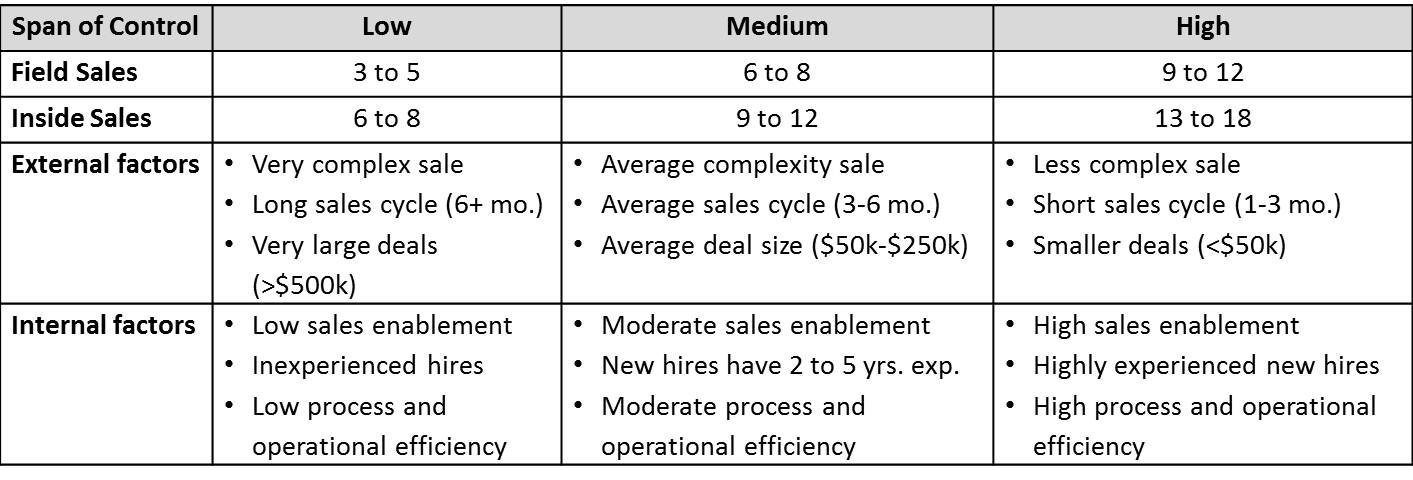What is the right span of control for first line sales managers (FLSMs)?
You are in the process of rolling out your FY Sales Plan and you might be wondering, do you have the right number of first-line sales managers (FLSMs)? What is the right number? In most sales organizations the FLSMs handle some of the most important tasks and thus have a significant impact on the success of the sales force. They help recruit, on-board, train, coach, develop, co-sell, and performance manage the front line. They manage internal communications. They may also manage critical customer relationships. So do you have the right number of them? If you have too few, the ones you have are spread too thin and unable to effectively carry out all these duties. But too many is costly. Trim down the number of FLSMs a little and you easily fund several more reps, increasing your sales capacity.
The average FLSM has 8 ½ direct reports. But, the range is huge, stretching from as few as two to as many as thirty-eight. Here are five factors to consider when determining the right span of control for your FLSMs:
- Sales channel (field direct, field channel, or inside). Field sales models often require lower spans of control (fewer reps per FLSM) than inside, where day-to-day in-person supervision can allow for 20% to 80% more reps per manager.
- Type of Selling (Transactional, Relationship, Solution, or Partnership). In an earlier article I described a continuum of four different selling models that increase in complexity, average sales cycle length and average deal size. The FLSM span of control diminishes as these factors increase.
- Hiring Model (Experienced Hires vs. College Grads). Sales hiring models vary, and typically the key difference is the degree of prior selling and industry experience required. Recruiting fresh talent either right out of school or with only few years of experience requires more hands management and training, often on the part of the FLSM, thus a lower span of control is needed than with more experienced hires.
- Sales Enablement Tools and Resources. Simply put, the more help the reps receive through effective tools and sales support resources, the more the FLSM can focus on higher value management activities. The more reps must rely on their own efforts for everything from lead gen to post-sales support, the more involved the managers will be in these activities.
- Operational Efficiency. How well defined and consistently executed is the sales process? Is there a consistent approach to pipeline management? How efficient are the steps for providing customer quotes, configuring solutions, processing orders, shipping and/or installing solutions, and managing customer care? The more efficiently your firm handles the pre- and post-sales processes, the easier it will be for your FLSMs to manage more reps.
Here is a quick guide for B2B sales organizations based on the above factors and the Alexander Group’s benchmark database: Keep in mind these are guidelines and while helpful, the best answer will depend on your unique situation. The amount of experience the FLSM has is also a factor. More experienced FLSMs will be able to handle a larger span of control. And, some sales organizations use a “player/coach” model where the FLSM has a hybrid role both managing reps and also carrying an individual quota. This approach requires a lower span of control.
Keep in mind these are guidelines and while helpful, the best answer will depend on your unique situation. The amount of experience the FLSM has is also a factor. More experienced FLSMs will be able to handle a larger span of control. And, some sales organizations use a “player/coach” model where the FLSM has a hybrid role both managing reps and also carrying an individual quota. This approach requires a lower span of control.
FLSMs spend an average of 16% of their time coaching. That’s only four hours in a 40-hour work week. Best practice is nearly double that figure at 28%. This delta is driven primarily by internal factors such as operational efficiencies and effective sales enablement.

Get in Touch With Our Experts
Where does your sales force stand? Contact the Alexander Group to learn how to benchmark your sales force against the market and best practice. We can also help you determine the right investment in FLSMs!
